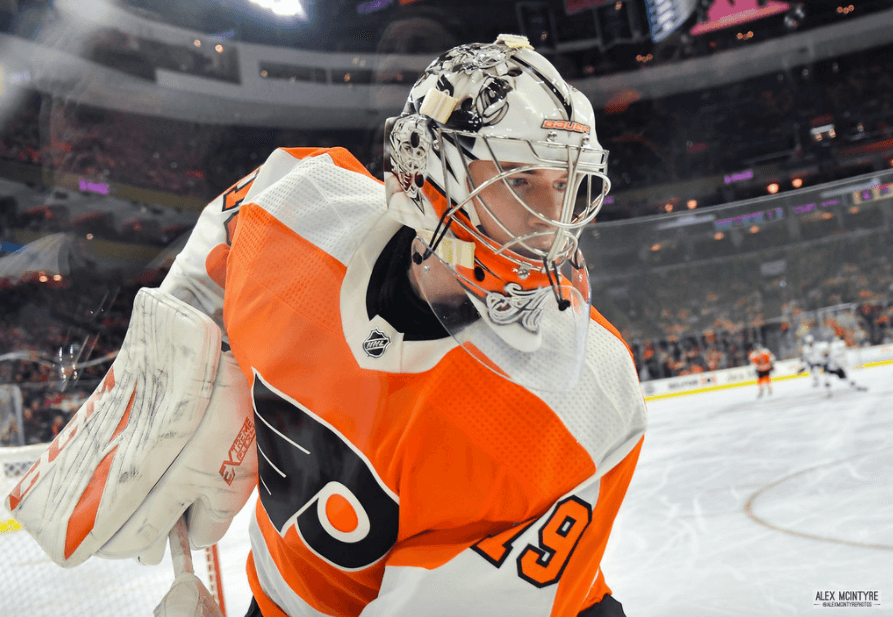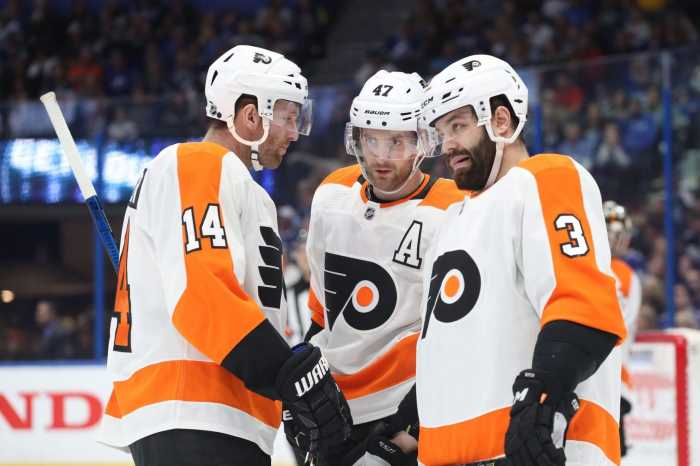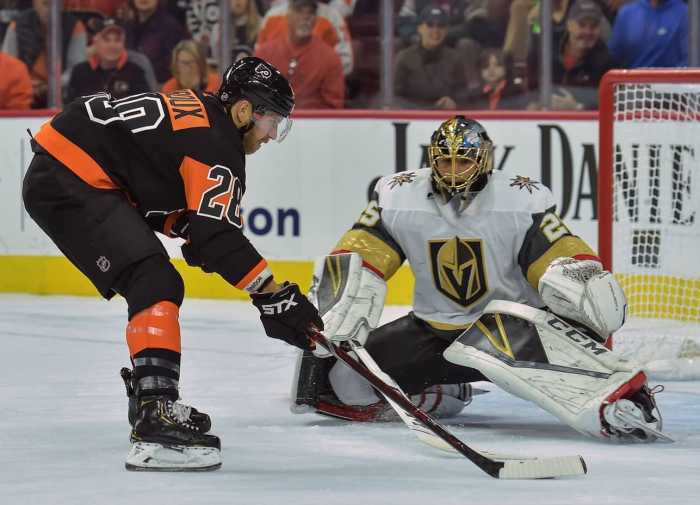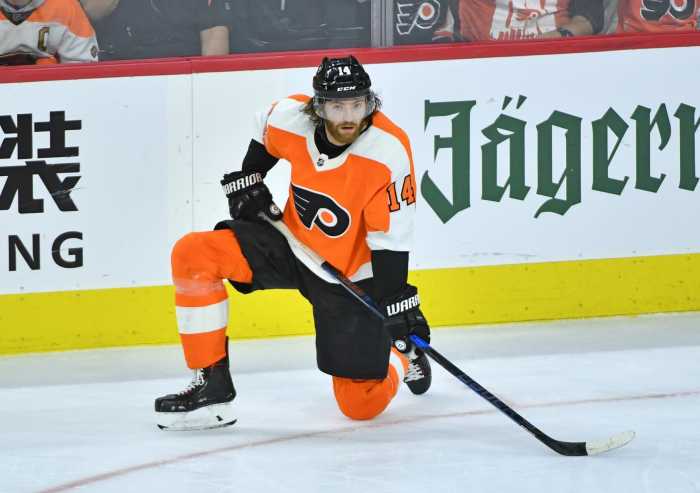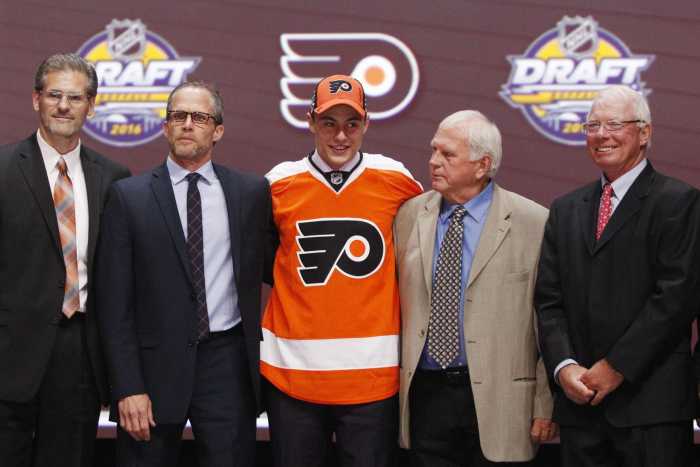The clock has been ticking on the countdown to Carter Hart’s extension. Sure, there was some business to tend to this off-season, and still is, but it’s never too early to look towards the future. That future needs to include Carter Hart at all costs. Ironically, that cost may not be as high as some may think.
It’s probably the biggest fear surrounding Flyers fandom entering the 2021 off-season. The position the Flyers are in regarding the salary cap right now, paired with what they might have to shell out next year has fans in a bit of a tiz. Michael Raffl and Scott Laughton are the only two current NHL forwards that will become free agents, freeing up $3.9mil collectively. Add in Travis Sanheim, Erik Gustafsson, and Brian Elliott, you have a total of $11.65mil coming off the books, not including Hart’s $730k.
Next offseason may come with even more difficult decisions to be made than this one, but there’s no reason to think that Chuck Fletcher won’t be able to make things work. So far as Flyers General Manager, he’s signed Ivan Provorov and Travis Konecny to relatively cheap, long-term deals. He gave Travis Sanheim a bridge deal to make sure Konecny and Provorov got locked up long-term. He brought in Matt Niskanen, Justin Braun, and acquired Derek Grant and Nate Thompson at the trade deadline. Fletcher knows how to navigate the salary cap.
For all the worries about Carter Hart’s next contract, there’s definitely room for optimism. Considering past starting goaltenders and their first contracts after their ELC’s, Hart’s first deal may not be as expensive as initially thought. Players are typically overvalued by their fanbase, and understandably so. However, the realistic outlook is that Carter Hart won’t necessarily break the bank.
Comparables to Carter Hart
A majority of starting goaltenders in the NHL signed less-than lucrative deals after their ELC’s expired. Obviously inflation will play a part in Hart’s deal compared to the one’s to be discussed.
Tuukka Rask – BOS
Tuukka Rask didn’t have quite the resumé that Hart did, but we all know how he turned out. The former Vezina Award winner was 3-1-1 while playing under his ELC with a .919 save percentage. In November of 2009, Rask signed a two year deal that would pay him $1.25mil per year for two years.
The year after he signed his first standard contract, Rask had arguably his best season to date. He posted a 22-12-5 record with a .931 save percentage and 1.97 goals against average. Rask would go on to win the Stanley Cup in 2011 as Tim Thomas’ backup. Not the most glorious of ways to do so, but nonetheless, Rask has himself a ring.
Connor Hellebuyck – WPG
Perhaps the most similar to Carter Hart, Hellebuyck began his career going 39-30-5 under his ELC with the Winnipeg Jets. His save percentage stood at .910 as well. Hellebuyck split time with Ondrej Pavelec early on in his career before earning the starting job. When he finally got the chance to shine, he didn’t look back.
Before turning into the goalie he is today, Hellebuyck’s first standard contract was a one year, $2.25mil deal signed in July of 2017. He made that deal count, going 44-11-9 during that year with a .924 save percentage and a 2.36 goals against average. He also was runner-up for the Vezina Trophy.
Carey Price – MTL
The man Carter Hart looks up to the most, Carey Price, had a somewhat similar start to his career as Carter Hart. Price endured more in terms of workload, going 60-48-18 while on his ELC with the Montreal Canadiens. He posted a .912 save percentage over that span as well.
In September of 2010, Price inked a two year deal worth $2.75mil annually. The very next season, Price went 38-28-6 with a .923 save percentage and 2.35 goals against average. He also finished fifth in Vezina voting.
Braden Holtby – WSH
Braden Holtby’s career began in 2011. Over the course of his ELC, Holtby went 37-16-4. He posted a .923 save percentage to boot. Solid record, great save percentage, and he was rewarded in February of 2013 with a two year contract worth $1.85mil per year.
His first full season under his new contract, Holtby continued to succeed. He went 23-15-4 during the 2013/14 season and posted a .915 save percentage along with a 2.85 goals against average.
Compared to Carter Hart
Carter Hart has about one and a half seasons under his belt thus far in his career. While still new to the game, he’s shown poise beyond his years. In 74 career games played, Hart boasts a 40-26-4 record with a .915 save percentage and 2.59 goals against average.
Determining Factor
One thing that needs to be taken into account is when Carter Hart signs his extension. There’s a lot that can happen over the course of an NHL season, and it can either negatively or positively impact what Hart’s next deal will look like. If Hart comes out and blows the doors off of the Wells Fargo Center, Fletcher better open up his wallet. If he has a down year, Fletcher will undoubtedly use that to his advantage.
What To Expect
It’s extremely difficult to gauge what Carter Hart’s next deal will look like. It will likely happen at the end of next season, whenever that may be. It will surely hinge on how he performs during that span. If he stays par the course, one might expect a deal somewhere in the range of $4-5 million.
Of course, there’s the question of term as well. Does Chuck Fletcher want to lock Hart up long term? The answer should be a resounding yes. If so, he will likely have to shell out more money. If he goes bridge deal, he’s going to be paying Hart less. Simple math.
Obviously Hart is due a big raise. Hell, he’s making $730k right now. The day Chuck Fletcher joined the Flyers, he was aware that Hart would need a new deal when his ELC ran out. Looking at past deals for high-end goalies, it’s fair to assume that Hart isn’t going to get current Bobrovsky-like money, but he isn’t going to sell himself short. The deal will be fair, but it won’t be as much as some may think.
Mandatory Credit – Alex McIntyre

